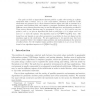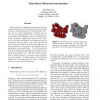85 search results - page 17 / 17 » Robot Motion Planning using Hyperboloid Potential Functions |
IROS
2006
IEEE
14 years 1 months ago
2006
IEEE
This work is about the relevance of Gibson’s concept of affordances [1] for visual perception in interactive and autonomous robotic systems. In extension to existing functional ...
SIAMCOMP
2008
13 years 7 months ago
2008
Our goal is to find an approximate shortest path for a point robot moving in a planar subdivision with n vertices. Let 1 be a real number. Distances in each face of this subdivis...
ICRA
2005
IEEE
14 years 29 days ago
2005
IEEE
— A new distributed coordination algorithm for multi-vehicle systems is presented in this paper. The algorithm combines a particular choice of navigation function with Voronoi pa...
NN
2002
Springer
13 years 7 months ago
2002
Springer
This paper presents a biologically-inspired, hardware-realisable spiking neuron model, which we call the Temporal Noisy-Leaky Integrator (TNLI). The dynamic applications of the mo...
PG
2007
IEEE
14 years 1 months ago
2007
IEEE
Minkowski sum is a fundamental operation in many geometric applications, including robotics, penetration depth estimation, solid modeling, and virtual prototyping. However, due to...


